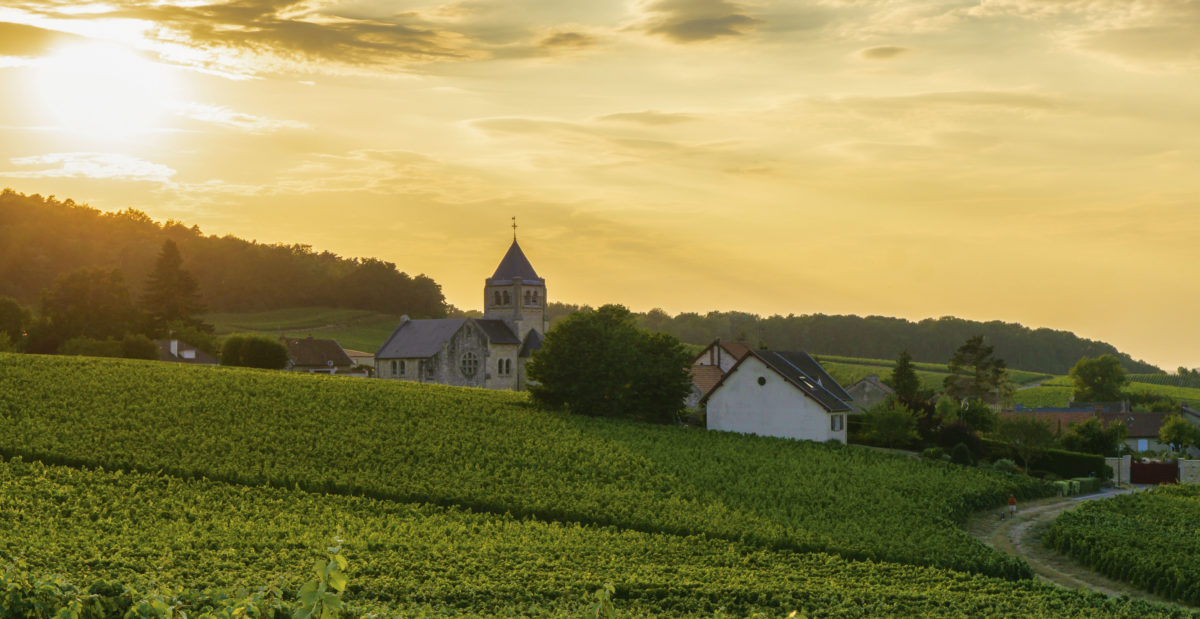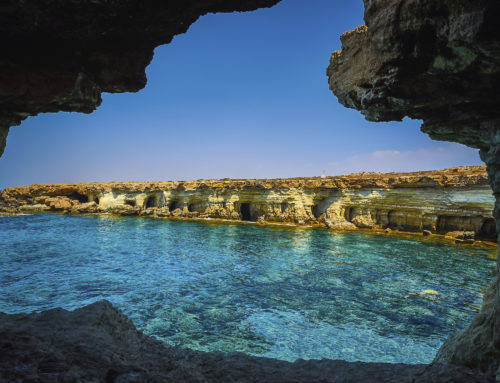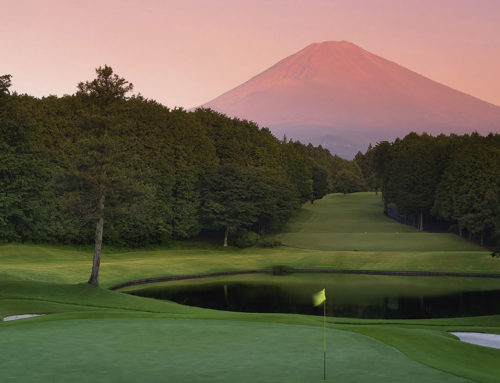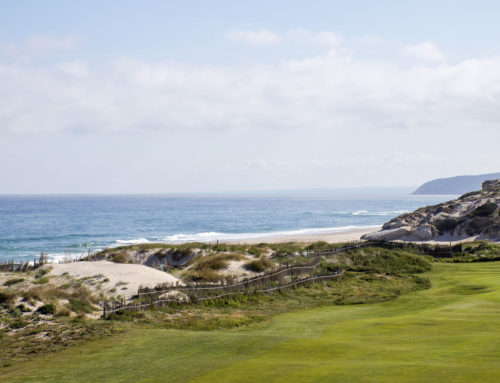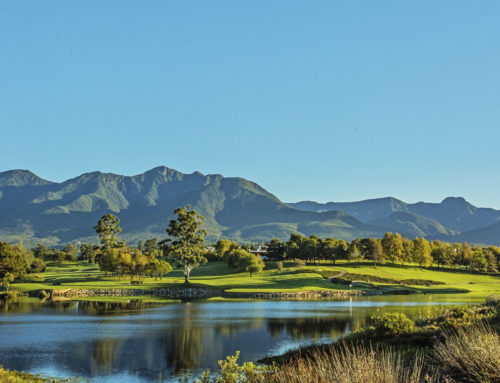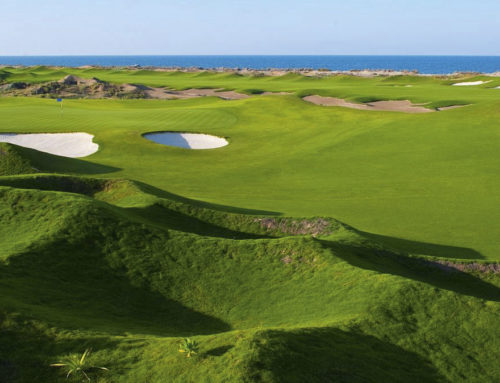FRANCE WITH FIZZ
Golf de Reims, Champagne
It was the monks from the south — the famed Languedoc wine region — who are said to have discovered the secrets to perfect sparkling wine first, but in the chalky soils and temperate climate of Champagne in the northeast of France, they found the perfect terroir.
The undulating landscape of these hillside vineyards, just over two hours from Paris, nurtures the pinot noir, pinot meunier and chardonnay grapes so they are ideal for making what we now know as Champagne. So intimate is the bond between soil, grape and the end product, that only sparkling wines made in this region can be classed Champagne; anything else, well, just isn’t.
With 84,000 acres of vineyard, served by 12,000 or so wine growers and producing somewhere upwards of a million bottles of Champagne per day, all stored in some 155 miles of cellars, it’s perhaps no surprise the region caught the eye of UNESCO to gain World Heritage Site status.
Not alone in the region when it comes to this accolade, the city of Reims gains double UNESCO bragging rights for its own Cathedral of Notre-Dame, over 800 years old and ‘bigger than the one in Paris’ as anyone local will tell you. Decorated with an incredible 2,303 gargoyles, animals, kings and biblical figures, it’s a stop-in-your-tracks cathedral. It also has the Palace of Tau, the former palace of the Archbishop of Reims and where 25 French princes were crowned king, from 1223 to 1825, including Charles VII who was joined by none other than Joan of Arc.
Reims is also home to another fine use of terroir, namely Golf de Reims, a parkland course that was initially opened in the 1920s to entertain English oenophiles visiting to sample the local sparkling delights. At the epicentre of this par-72, 6,621-yard course is the beautiful moated clubhouse, part of the ‘Dames de France’ chateau, named so because King Louis XV’s daughters stayed there (in one of its former lives). A land that’s hosted local counts and archbishops, visiting kings, armies (the Russians were stationed here during the Battle of Reims), is now home to far more sedate happenings. The initial nine-hole course was upgraded to an 18-holer in the 1970s that now weaves its way through woodland, in and around ponds and lakes, and is as serene and idyllic as you’d expect, until you get caught by one of the double breaks on the greens. It’s beautiful, but not without a few harsh realities of golf course design thrown in.
Luckily, the menu at Brasserie du Chateau des Frances offers a nice variety of local and more international dishes, but it’s almost compulsory to try everything with some of the finest local bubbles — steak frites and Champagne anyone?
golf-de-reims.com, green fees from £40
PALATIAL FRANCE
Golf de Fontainebleau, Seine-et-Marne
Just to the south of Paris, 30 or so miles, is the Forest of Fontainebleau, an area so full of character that it’s said to have inspired countless French landscape artists. You can’t blame them for getting caught up in the 110sq miles or so of untamed beauty, with its entangled trees, ancient oaks, thin-limbed, thickly covered pine and sprawling beech. Or it could have been the curious rock formations, some seeming to have the face of a thousand ages carved into them. Those it’s enthralled over the centuries include of Claude Monet, Alfred Sisley and Auguste Renoir — it even featured in The Scarlet Pimpernel and Verdi set his opera Don Carlos here, too. It’s been a royal playground, the forest being a prime site — a comparative stone’s throw from the capital — for numerous kings to blow off steam hunting deer or boar.
These days, while there’s still deer, boar and rabbit in these woods, there are no royals hunting them, while the best sport to be found is probably a more serene search for a birdie or even an eagle. While Golf de Fontainebleau may have arrived too late — around 1909 — to entertain any French royalty, they’d no doubt have approved. Designed initially by Tom Simpson and later tweaked by many, included Fred Hawtree in the 1950s, it remains as picturesque as any course you’ll see. Overseen and peppered throughout with clumps of those pine, beech and oak trees — the woodland is both the best and worst part of the course; best, for making it both stunning and challenging; worst, sometimes they’re overzealous on the latter. Either way, as settings go, you’ll struggle to do better — tee off first thing, or at twilight, to find some of those deer casually joining your round.
The golf courses is on the edge of the of the same name, but even the forest with all its natural majestic beauty has to bow to the magnificence of the town’s centrepiece, the Palace de Fontainebleau. A medieval royal hunting lodge since the 12th century, it was continually developed, rebuilt, tweaked and finessed until it became the fine example of opulent grandeur it is today. It was a royal residence for every French king from Louis VII to Napoleon III and, even after a single glance, you won’t be surprised to learn that the king who had the biggest impact on its structure, Francois I in the 16th century, was intending to base a ‘new Rome’ around it. The result is a mix of French and Italian styles, with pristine resplendent gardens — all of which is deemed worthy of UNESCO World Heritage Site status.
golfdefontainbleau.org, green fees from €80
RYDER CUP FRANCE
Le National, Paris
The Ryder Cup is going to be the biggest thing that’s ever happened to golf in France. And whether you’re reading this before or after the event and whoever has won, be that the US retaining their crown or Europe hitting back in true nail-biting fashion, you’ll want to play Le National after you’ve see it in action.
Rory McIlroy v Jordan Spieth, Dustin Johnson v Justin Rose, or even a legend like Tiger Woods against Ryder Cup debutant Tommy Fleetwood — whatever the pairings, or foursomes, Le National will have seen things. As soon as it was confirmed that France, specifically Paris, was to be the first mainland European nation to host the Ryder Cup since Spain’s Valderrama in 1997, the golfing world has been champing at the bit to descend upon the world’s culinary capital. American tourists love France already, so throw in Ryder Cup golf — and with their golf game in the ascendency — and it’s not surprising many are desperate to tackle Le National’s undulating green-grass carpets. There are three courses at the site (two 18-holers and a nine-hole), just outside Versailles, but it’s Albatros that will see/have seen the action. Big theatre golf is what the course was intended for when American Robert von Hagge (with over 250 courses in 20 countries to his name) and Frenchman Hubert Chesneau designed it in the 1980s, and the aim is finally coming to fruition. After hosting the French Open on 25 occasions, the Ryder Cup will then be followed by the 2020 Olympics. And you can expect both to be full of fierce contests; the Albatros course, full of risk/reward opportunities, lends itself perfectly to the death or glory matchplay format. It was built on an old municipal site, but it’s got all the man-made curves and contours in the right places from an aesthetic point of view, and there are plenty of stunning holes — but don’t expect much respite or for your handicap to be given any help. It’s a tough course, which is exactly what spectators want — so remember those moments of excitement you enjoyed while watching the Ryder Cup, as your own ball falls victim to yet another sand trap or falls far short of
the green.
Beyond the course, the Novotel is good enough, but make sure to explore nearby Versaille, which aside from the palace, has some spectacular restaurants too.
golf-national.com, green fees from £175
MEDIEVAL FRANCE
Golf de Carcassonne, Languedoc
Carcassonne is jaw-dropping. It’s heart is a fortified, medieval city — the citadel, the Cité de Carcassonne, which is a fantasy fortress it’s hard to believe really exists. Basically ever since it was first a Roman hilltop fortress back in 100BC, generation after generation has added layers of fortification, to the extent that it looks like a place that’s repelled fire-breathing dragons and anything a trebuchet could throw at it. It’s fought crusading armies, it’s held inquisitions and repelled princes, and inspired poets and wordsmiths. While the ancient streets are today lined with restaurants and shops, not to mention museums dedicated to torture and chivalry, there are still people living there, albeit in tens rather than the thousands who once lived within the protection of its thick walls.
From its walls, it’s possible to see for miles, to the surrounding vineyards of the Languedoc-Roussillon region, which produces a third of France’s wines from its 700,000 acres or so of vines which are home to grapes such as cabernet sauvignon, grenache and syrah, to sauvignon blanc and chardonnay.
It’s fitting, given a golfers’ known penchant for a drop on the 19th, that Golf de Carcassonne is within the ancient vineyards of Domaine d’Auriac, which is also home to a Michelin-starred restaurant. The course is a par-71, 5,800 metres, designed by Jean-Pierre Busurco in the 1980s, and while it won’t trouble the single handicappers, it still makes for a tranquil round with some stunning views of the surrounding countryside, so nobody is going to complain, especially if they return with a good-looking scorecard. What makes this even better from the discerning golf traveller’s perspective is the dining. Chef Philippe Deschamps’ food is undeniably French, but has plenty of modern twists and more Mediterranean turns — although always full of flavour. Plates include crispy lamb sweetbreads with aubergine and braised shoulder of lamb or gilt-head bream with courgettes, cuttlefish and madras curry sauce. The wine selection and being able to take advantage of the sommelier to unpick the list, is another major boon of visiting Carcassonne.
domaine-d-auriac.fr, green frees from £37
WINELAND FRANCE
Golf du Médoc, Bordeaux
Early autumn is not only a great time for a golf holiday in the sunnier climes of Europe, but also perfect for timing golf travel with the wine harvest. As growers begin to pluck grapes from the vines in villages and towns across wine regions, the locals celebrate the bounty of the harvest with banquets and festivals — none more so than Bordeaux where some chateaux open to the public for the only time in the year. In France’s biggest wine region, the 9,000 or so wine producers have some 300,000 acres of vines to harvest, and they’ll be picking everything from merlot, cabernet sauvignon, and cabernet to malbec, saugivnon blanc and muscadelle. Like its fellow wine region Champagne, Bordeaux — in the south west of the country, has earned UNESCO World Heritage Site status. Wine has been made in these parts for around 2,000 years, and its famous reds (which make up 90% of the wine produced), are the stuff of oenophile legend the world over.
The first call for golfers in Bordeaux is inevitably Golf du Médoc Resort which has two 18-hole courses, Chateaux and Les Vignes. Every hole on the often breezy (thanks to Atlantic Ocean winds) par-74, 7,192-yard Chateaux is named after a Medoc vintage, and American architect Bill Coore (who has worked on Streamstrong (Red), Pinehurst #2 and Shinnecok Hills) has ensured there’s plenty to challenge golfers of all levels. It’s also been voted French golf course of the year in recent times. Sister course Les Vignes arrived on the scene two years after Chateaux in 1991, and might not get the press or indeed the French Open (Chateaux played host in 1999 when South Africa’s Retief Goosen saw off New Zealand’s Greg Turner in a play-off for the title) but its long par fives and well-protected greens give more than enough to think about.
golfdumedocresort.com, green fees from £52
SEASIDE FRANCE
Golf Barrière de Saint-Julien, Normandy
There are so many reasons to visit Normandy, yet so often it’s overlooked, even by those living just a short hop across the channel in the UK. The history alone should be enough, with the Vikings, the Normans and the D-Day landings just some of the chapters in a rich and varied storyline going back thousands of years with a cast of millions. Richard the Lionheart’s hilltop castle in Les Andelys conjures up a thousand potential stories all by itself the second one sets eyes upon it, and the Bayeux Tapestry in the eponymous town is one long, artfully crafted, embroidered book of tales. The cathedrals (Rouen and Coutances) and Mont Saint Michel Abbey are as impressive as any in France, and the countryside of farmland and fruit-rich orchards is as ruggedly rural as anyone could want for a true break from city life. The beaches — with Omaha perhaps the most famous the world over for it’s part in the D-Day landings — are rather under-rated from a tourism point of view. While Normandy doesn’t have the glitz of the south, these coastal retreats have a seaside charm that’s almost English in style. The gentle sandy arcs might take the occasional beating from the channel winds, but it gives them a windswept charm for bracing walks in the autumn, and in summer, when the tides are low, they offer prime sandcastle real estate unlike anywhere else, for those inspired to build their own life-size fortress. Sand put to a different use — depending on how your game is going — can be found at L’Hôtel Du Golf in Deauville, which has 27 holes designed by Tom Simpson (18 holes) and Henry Cotton (nine). The options — whichever way the three nines are mixed, they’re either par-71 or 72 — can keep players busy for at least a couple of rounds and ensure players see the best of the golf offering and take in some seaside views as well. The half-timbered hotel is a fitting destination to shoot for, as the clubhouse has hospitality as famed in golfing France as the course itself.
hotelsbarriere.com, green fees from £44
WATERWORLD FRANCE
Aa Saint-Omer Golf Club, Hauts-de-France
A short drive from the ports of Dunkirk and Calais, is Saint-Omer, a quaint market town full of character, history and artistry with plenty to do in and around it. This includes the UNESCO-protected Audomarois marshes, a maze of waterways (435 mile’s worth if laid end-to-end), which are home to countless flora, fauna and water-based wildlife. Boat trips through the marshes are essential for any visitor. Back on dry land, head for Saint-Omer Cathedral — which took some three centuries to build — or the columned town hall with its Italianate theatre.
Perfect as a base for visiting the marshes is Najeti Hôtel Du Golf, home to the Aa Saint-Omer Golf Club. This is no slouch in golfing terms either, such is the calibre of the golf here, it has hosted a European Tour and then Challenge Tour event since 1997. The Hauts de France Golf Open began life as a European Tour event, but a date clash with the US Open meant it was switched to Challenge Tour status. Nonetheless, the course — overlooking the spectacular Aa river valley, with a varied terrain, and plenty of woodland challenges — remains a popular stop for all the professional golfers it puts to the test every year, competing for a €28,000 (£24,950) top prize.
golfsaintomer.fr, green fees from £42

